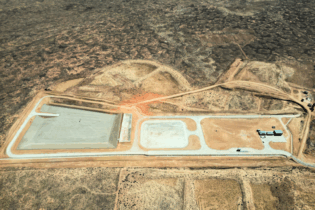Photo: Bruce Engelsman, SRK Consulting
According to Bruce Engelsman, a partner at consulting engineering firm SRK Consulting, South Africa leads the way in waste management in Africa, but many other countries on the continent are up to speed with their environmental legislation – usually based on World Bank standards. “Elsewhere in Africa where national waste management standards are not yet in place, then South African standards are applied with the agreement of clients and authorities,” said Engelsman. This may happen when infrastructural capacity – like the logistical infrastructure – lags behind the project development boom. “Appropriate waste management is often one of the casualties, as waste is often produced prior to any meaningful waste management strategies or infrastructure being in place,” he said. Turning the law into action is, of course, the key challenge – and this is where the role of guidelines is invaluable: to help standardise the way that authorities at various levels apply the legal requirements, and the formats in which they plan, licence, monitor and report. To ensure that our laws are well implemented, SA’s National Waste Management Strategy requires local authorities to develop Integrated Waste Management Plans (IWMPs) which must be integrated into those of their respective District Municipalities, and then eventually integrated into a Provincial Waste Management Plan. As a tool to help local authorities in KwaZulu-Natal, SRK Consulting was contracted by the province’s Department of Agriculture and Environmental Affairs to develop guidelines that would lead to high quality IWMPs in a standard format. “The guideline document is therefore to build capacity and guide municipalities,” said Kirsten King, senior environmental scientist for SRK in KZN. “It gives the user a step-by-step approach to key issues like what information their plan needs, how the data can be obtained, and how to generate information from the data.” An IWMP needs to be regularly reviewed, updated and expanded, and must include an implementation plan that specifies required action, timeframes and budgets, said King. “Guidelines help all municipalities to plan and budget for their waste management activities in a methodical format, so that they feed easily into the integrated development plan (IDP) process,” she said. However, capacity and financial constraints nevertheless result in many municipalities in rural areas still using disposal facilities which are informal and unlicensed. “In this respect, the focus of waste management in many smaller municipalities is on developing formal licensed waste disposal facilities and extending waste collection services beyond the formal urban areas,” said King. There is also much work to be done in terms of implementing accepted waste management principles based on the ‘waste hierarchy’ – where waste should first be reduced, reused and recycled. Disposal in landfill sites, for instance, should be a last resort.Among the factors that should encourage governments all over Africa to implement the waste hierarchy is the high cost of appropriately designed landfills.
“The cost of implementing appropriately designed landfills in Africa is high,” said Engelsman. “This is often due to remoteness of locations and lack of locally available resources and products. The logistics involved in constructing landfills outside of South Africa are also cumbersome and contribute to costs and project delays.” But where there is political will, there has been substantial progress, he said. Having successfully completed two large projects in Angola, Engelsman said the Angolan authorities clearly displayed their commitment to ensure low environmental impacts when it came to waste management. “Licensing is required, as well as monitoring and follow-up auditing – and commitments made at environmental impact assessment stage are well policed,” he said. In addition to design standards and commitment by government authorities, there has been a recent technical innovation in lining systems that has also made its contribution to more effective waste management. Among the most important aims of responsible landfill design is to reduce the risk of contaminants migrating from impounded waste into groundwater resources. This means that appropriate lining systems must be used at landfill sites, as specified in the Department of Water Affairs and Forestry Minimum Requirements Series, drafted in terms of the National Water Act of 1998. “These lining systems must provide impermeable barriers, as well as integrate leachate management and leakage detection systems,” said Engelsman. “The standards in this regard suggest that natural clay materials be used as components of composite lining systems. These clay materials themselves need to meet certain minimum requirements to ensure that they are can be used to provide effective barriers, but many waste sites do not have geotechnical profiles with suitable clay materials.” To meet the specifications imposed by engineers for clay lining components, clay material may have to be transported from elsewhere – usually at considerable cost. Indeed, the cost may often retard the progress of the project or lead to downscaling of landfill capacity. “Alternatives to natural clay liners have therefore evolved,” he said. “Geosynthetic clay liners (GCLs) in particular have become popular. These consist of geofabrics which incorporate bentonite or other clay material and that collectively form a barrier of low hydraulic conductivity – the same effect as the clay liners.” The significant difference between GCL and clay liners is their dimensions. While GCLs are typically one centimetre thick, the minimum requirement for clay lining components can require multiple layers of between 20 cm and 60 cm thick. “Each of these components, if replaced by GCLs, reduces the composite liner thickness considerably,” he said. “In addition, leakage detection and leachate collection layers previously consisting of natural sand or stone layers can now be replaced with commercially available products. Once again, the advantage is that these products are more compact and reduce the composite liner thickness.” It is not just the importation of clay materials that is costly, but the additional excavation requirements to make room for constructing thick composite clay liners. When these costs are weighed up against the purchase and installation cost of GCLs, the latter is usually more cost-effective. “An example to highlight this is a recent project conducted for a client where two waste facilities were designed, one to carry solid waste and another liquid waste,” said Engelsman. “Capital implementation cost savings for the solid waste disposal facility was 23% using commercially available products, including GCLs, instead of clay. In the case of the liquid waste facility, this cost saving was in the order of 10%. In both cases, the liner integrity was not compromised. In the case of Angolan landfill projects, these cost savings are generally higher.”







